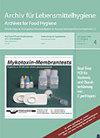Experimental accumulation and persistence of norovirus, feline calicivirus and rotavirus in blue musseis (Mytilus edulis)
IF 0.2
4区 农林科学
Q4 CHEMISTRY, APPLIED
引用次数: 4
Abstract
Outbreaks of viral gastrointestinal diseases due to the consumption of contaminated shellfish have been repeatedly reported. Human pathogenic viruses may accumulate in shellfish after faecal contamination of the growing area and thereafter persist tor several weeks. Here, blue mussels (Mytilus edulis) were contaminated with noroviruses and rotaviruses for 24 hours in a recirculation artificial seawater system. Noroviruses were found to be enriched 100 to 1000fold within the mussels and persisted therein for at least 4 weeks as assessed by semiquantitative real-time RT-PCR. In contrast, rotaviruses were not efficiently enriched in shellfish and they were only detectable tor approximately one week using realtime RT-PCR and cell culture. Feline calicivirus, used as surrogate for norovirus infectivity testing, was also only detectable in shellfish for approximately oneweek. For rotavirus, the inactivation kinetics in shellfish and contaminated seawater were largely similar. In contrast, norovirus was highly stable in shellfish for at least 4 weeks, but the amount declined in seawater and was no longer detectable therein at 3 weeks after contamination. The results indicate a unique mechanism of norovirus enrichment and persistence in shellfish. For improvement of microbial safety, surveillance may be focused on detection of noroviruses in shellfish samples.诺如病毒、猫杯状病毒和轮状病毒在蓝贻贝(Mytilus edulis)体内积累和持续的实验研究
由于食用受污染的贝类而爆发的病毒性胃肠道疾病已被反复报道。人类致病性病毒可在贝类养殖区被粪便污染后在其体内积聚,并持续数周。在这里,蓝贻贝(Mytilus edulis)被诺如病毒和轮状病毒污染了24小时,在一个循环的人工海水系统中。通过半定量实时RT-PCR评估,诺如病毒在贻贝体内富集100至1000倍,并在贻贝体内持续存在至少4周。相比之下,轮状病毒不能有效地在贝类中富集,并且通过实时RT-PCR和细胞培养只能检测到大约一周。猫杯状病毒,作为诺如病毒感染性测试的替代品,也只能在贝类中检测到大约一周。轮状病毒在贝类和污染海水中的失活动力学基本相似。相比之下,诺如病毒在贝类中至少在4周内高度稳定,但在海水中含量下降,在污染后3周不再检测到。结果表明诺如病毒在贝类中富集和持续存在的独特机制。为提高微生物安全性,监测工作应重点关注贝类样品中诺如病毒的检测。
本文章由计算机程序翻译,如有差异,请以英文原文为准。
求助全文
约1分钟内获得全文
求助全文
来源期刊

Archiv Fur Lebensmittelhygiene
工程技术-毒理学
自引率
0.00%
发文量
0
审稿时长
>12 weeks
期刊介绍:
The "Journal of Food Safety and Food Quality“ provides a platform for papers including case studies and discussion papers dealing with topics from all areas of food hygiene (food originating from animals) including dairy hygiene, food monitoring, beef cattle and meat examination, meat hygiene and food technology.
 求助内容:
求助内容: 应助结果提醒方式:
应助结果提醒方式:


